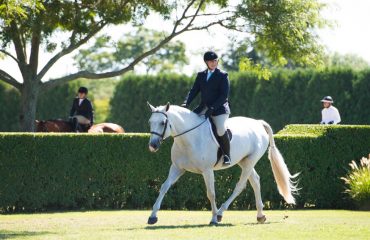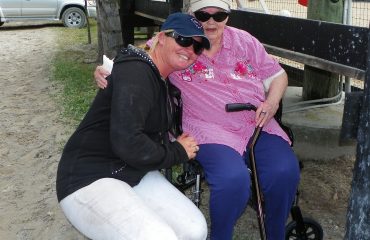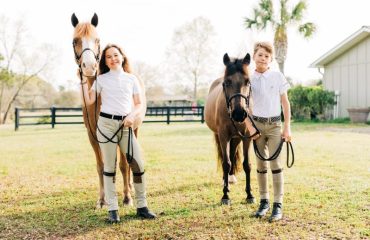
Chrissa and Mireill, owned by Chris and Robert Desino of Wellington Equestrian Realty.
Photo courtesy of the Desinos
By Lauren R. Giannini
It isn’t that anyone said it couldn’t be done. It just hadn’t been tried, at least not in public. But dressage trainer Chrissa F. Hoffmann thinks outside the box and the dressage arena.
She isn’t biased about breed and proved it by riding and training an American Saddlebred named Harry Callahan – a gaited horse, for heaven’s sake! — all the way from just started under saddle to Grand Prix in Wellington in 2006, where they scored 65 percent or higher, placing in the top six against some of the best Warmbloods on the Grand Prix circuit. But a gaited horse — the kind that racks?
“A horse is a horse at the end of the day, and dressage is training — if a horse has three good gaits and a good brain and a good work ethic, why not see how far it can go? Training is about developing the horse’s potential,” said Chrissa. “I think that me doing that and stepping up out of the box, going all the way to Grand Prix with Harry — well, first of all, it is a bit of a fairy tale, but there’s so much reality and truth behind it — but it’s all about good training with a horse that wants to do it and is nurtured and brought along in the right way. It means that any willing athletic equine can learn dressage.”
To The Top
So far, Chrissa has trained 15 horses to FEI levels, six of them to Grand Prix. Her successes include another Saddlebred, a purebred Arabian, and a PMU (pregnant mare’s urine, used to produce Premarin) gelding. She exhibits a remarkable ability to read horses and riders and solve their problems with various movements.
“I broke Edykts Enchantres, my purebred Arabian mare, 11 years ago and we had shown Training Level through Intermediaire I when we met Chrissa,” said Courtney Varney, DVM. “I was having the trouble that so many FEI riders have, bridging the gap from Intermediaire I to Intermediaire II and, of course, to Grand Prix. We had no passage, piaffe or one-tempi canter changes. Chrissa explained riding these movements in a way that clicked, and in our first lesson with Chrissa I had seven one-tempis. From that point forward, she has helped me to teach my mare the passage and piaffe, which we’re still improving.”
Courtney and her mare recently earned their USDF Gold Medal, a mere nine months after their first lesson with Chrissa. “I’m so excited what the future will hold for my little mare now that she’s becoming more confident in the Grand Prix, and I have Chrissa to thank,” added Courtney, who will debut Zinerealla, a Dutch Warmblood mare found by Chrissa through her European connections, in the 4-year-old classes in Wellington.
Taking the Belgian-Quarter Horse PMU gelding, Fynn, to Grand Prix racks up yet another first. Karri McFadden loves the training process, but she wasn’t sure about the young horse her equine veterinarian husband, Dr. Derek McFadden, had seen at a client’s farm. The first time she rode the green PMU gelding, he didn’t exactly inspire her to dreams of equestrian glory. When she went back one month later, Fynn impressed her by remembering what she taught him about steering, brakes and going forward.
“Fynn is a really unique horse. He wasn’t bred for dressage, but he became the first horse I trained to Grand Prix,” said Karri, who bases Karri McFadden Dressage at CloverMeade Stables near Clarksville, Ohio. “I bought Fynn and two weeks later rode him in a clinic taught by Chrissa. He didn’t have a left lead and Chrissa said ‘canter and ask him to do a flying change’ — and he did! Chrissa told me not to sell this horse. Fynn was so willing to learn; he always gave everything. Chrissa said he’s the type to make it to Grand Prix in four years, but it took only three. I had already earned the two Intermediaire scores with another horse, and it took one weekend for Fynn and me to earn the Grand Prix scores for my USDF Gold Medal.”
Chrissa goes to great effort to ensure that her horses enjoy their lives and their work. “All of my horses go out with another horse, two or three to a field,” she said. “People look at me and say, ‘You’re crazy,’ but they’re herd horses and I leave them out as much as they want to be out. As for training, I always keep it fun for the horse. I don’t set a time. I get on, thinking this is what I want to tap into, and if they get it in 10 minutes, good horse — I get off or we go for a trail ride. The second it stops being fun for them, you come to a crossroad, because it has to be fun for them. Horses have to want to work for you. They have to enjoy their job. I want to enjoy my job! Doesn’t everybody want to enjoy their job?”
Hooked On Dressage
A bit of background explains how and why Chrissa is where she is today. “When I started out, I was a three-day eventer and grew up riding everything from an Appaloosa to a Thoroughbred, anything that had a good brain and a good temperament for the sport and, obviously, athletic ability,” said Chrissa. “My top horse at the time was Riley, an Argentine Thoroughbred, and he was getting ready to do his first three-day [long format] when he was injured in a trailer accident. We don’t know what happened — we think he bucked and got his leg stuck over the partition — but he ripped up his entire extensor tendon.”
Chrissa and Riley were on their way to train with Denny Emerson. “We pulled over in Ohio and long story short, Riley spent three months there at a vet clinic with a 25 percent chance of living, but he made it through,” recalled Chrissa. “The vet surgeon said he won’t ever be a jumper again, but he could possibly become a dressage horse. Riley was it. He was the only horse I had. At that time, I was living in Kentucky and Barbara Silverman, a professional dressage trainer, had just moved to town. I took one lesson with her and I was completely hooked. I never went back to eventing.”
Chrissa stayed as a working student for seven years with Barbara, who got into dressage at 19 when her jumper trainer, the great Bert de Nemethy, told her to focus on her flat work. Barbara had lived with cancer for 16 years: she was 24 when she learned that she had incurable ovarian cancer and four months to live. Horses were her passion and dressage energized her life. Recognizing the same zeal in Chrissa, Barbara took the young rider under her wing. At the time of Barbara’s demise on May 24, 2000, she had been competing with the goal of trying out for the U.S. Dressage team for the 2000 Sydney Olympics.
“When Barbara was dying, she told me I was her protégée and that I had to take on the business,” Chrissa said. “She told me to ride with Robert Dover and Tina Konyot. I was 22. I wasn’t ready for this, but that’s what happened. After Barbara passed away, I took on all of her clients. She did a lot of importing and sales, so I kept on with her contacts, because I had traveled so many times to Europe with her. I just went on from there.”
But it wasn’t easy. Chrissa took off the better part of a year, refining what she had learned from her mentor and friend. “I thought, I’ve got to figure out my own way. Everything that Barbara taught me is the true foundation,” said Chrissa. “I had all the basics, but I had to figure out my own style, because now it’s up to me to problem-solve. I need to know I have the right reaction when something happens. I spent that year alone, riding my own horses, training clients’ horses, until I got out of that sad, lonely place and felt confident that I was ready to go on.”
The Girl On The Saddlebred
Chrissa went to work for Full Circle Dressage, a farm in Kentucky, owned by Frank and Judy Gaston who specialized in Morgans and Saddlebreds. That’s where Harry Callahan, the Saddlebred, came into Chrissa’s life. Judy found Harry, 3, recently started at walk, trot and canter, but he hadn’t been taught to rack. A few months later, Judy sold Harry to Linda Cawthon.
“By the time Harry was 6, he was doing Third Level, by 8 he was doing Prix St. Georges with really good placings, by 10 he was at Grand Prix and really competitive,” said Chrissa. “I took him to Wellington and put him against our top horses at Jim Brandon Equestrian Center, 25 in his class and he was in the top six. I thought to myself, this is unheard of, we’re really making history here.”
You can check them out on youtube.com (search for Chrissa1): Harry, the American Saddlebred, will knock your socks off. Watch their performance at the 2006 American Freestyle Symposium — absolutely fabulous — but even Chrissa had moments wondering if she really wanted to be known as “the girl on the Saddlebred.”
“I’ll never forget, I was at Devon and Katherine Bateson, one of my good friends, said, ‘You know, who cares if it’s a Saddlebred — you’re the only one in the world who has done it.’ I thought, OK, she’s saying this and she’s a team rider, so respect it!” recalled Chrissa. “Harry and I literally became a worldwide thing. We have been featured in nine publications, including landing on the cover of USDF Connection, and on six websites. Thanks to Harry’s success, I was one of the first trainers featured in Dressage Training Online. I still get emails from people, saying, ‘You’re my inspiration’ — because the average person is not riding Valegro, the average person is riding something in the backyard, which is what Harry was. So, that taught me a lot — not to have that stigma — training is training. Harry’s first Grand Prix was on YouTube and the last I looked it had 30,000 hits.”
Recently, Chrissa moved her training facility from Ocala to Vero Beach, Florida, but still travels to teach clinics. She and her medical doctor husband have a son, now 7. In spite of how motherhood can affect many riders, Chrissa has continued to be passionate about training and competing and hopes to someday get a shot at making the team. A serious injury in summer 2013 changed her perspective about a certain aspect of her business: taking horses on consignment.
Life Changing Accident
“I do a lot of sales and have been very successful for years — until a horse came in on consignment that was cold-backed and I wasn’t aware of it,” said Chrissa. “He threw me hard, stepped on my head and broke three ribs. I didn’t ride for eight weeks. I always wear a helmet or I might not be here, but that injury made me look at horses differently. I decided to do only my horses. I want to stand behind my product, horses that I know I can put my own mother on, horses that I can trust. Sure, a horse is a horse and things can happen, but I’m not going to be responsible for selling a horse to someone unless I absolutely know this is a horse I feel comfortable riding. Having my son and being injured changed my perspective, but I’m still hungry for it every day. The aspirations are still there — we all want to be on the Olympic team, but all you can do is keep trying every day to make yourself better.”
With a stable full of dancing partners, Chrissa stays very busy. She’s focused on all of them, but several horses merit mention, including her own Scrabble, showing Prix St. Georges with scores above 70 percent and schooling Grand Prix; Faustus, a super-powerful 8-year-old gelding owned by Johan Ifverson of Sweden; and a new Danish Warmblood mare, Mireill, owned by identical twins Chris and Robert Desino of Wellington Equestrian Realty. It’s going to be an exciting winter circuit for Chrissa, her owners, students and staff.
“My brother Robert and I are thrilled with the opportunity for Chrissa to pick up the ride on our new horse Mireill,” said Chris Desino. “She’s a gorgeous and athletic horse. With Chrissa’s training and beautiful classical riding, we’re confident that they’re going to make a great pair in this upcoming season’s Grand Prix in Wellington.”
For more information visit www.cfh-dressage.com.















First off, American Saddlebreds are NOT a gaited breed. They are *taught* to do the rack and slow gait, just like Warmbloods are “taught” to piaffe and do tempis, they do not come out of their dam’s womb “skipping” or “prancing” any more than Saddlebreds are born racking. This kind of misinformation is EXACTLY why so many people shy away from buying a Saddlebred for the sporthorse disciplines, which is extremely unfortunate as they make fabulous, well-tempered, inexpensive alternatives to Warmbloods. Also, the beautiful photo of Chrissa and Forty Something is mis-labelled as being of Harry.
It would be wonderful if the author could correct both of these errors.
Happy trails!
Saddlebred are Not (ideally) naturally gaited. They walk, trot, canter just like any warmblood. This is a commonly perpetuated falsely, even by otherwise knowledgeable horsemen and women. The slow gait and rack are trained gaits. Saddlebreds can make very nice dressage horses…as Chrissa proved!
Harry was never gaited!
Some American Saddlebreds are trained to do the lateral gaits slow gait and rack. They have to have the propensity to do these gaits. Many never learn to do these extra gaits. Harry never had it in him to be gaited and was never gaited. He has the normal walk, trot, and canter. Also, this picture of Chrissa standing next to the bay horse with the white on his face is mis-labeled. That is the American Saddlebred Forty Something.
Correction – Harry wasn’t a gaited horse. Saddlebreds do all the normal gaits – walk, trot, and canter. Some have a stronger genetic predisposition to gait, and that gait is trained. Yes, there are a *few* individuals who are naturally gaited, but those are few and far between.
And Harry was not one of those. Nor did he show any inclination to gait – as his bloodlines were not the sort for a genetic predisposition. His full sister was shown as a traditional 3-gaited horse. While his bottom line has a genetic predisposition to gait, his top line is much stronger as a 3-gaited animal. He does have one half sibling who was very successful as a 5-gaited horse, but that horse’s sire was also known for siring 5-gaited horses.
Thanks for the article!